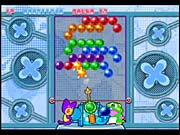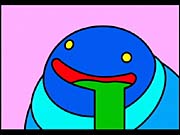Though you might infer from the game's title that Bust-A-Move 3000 is the latest and greatest iteration of Taito's long-running puzzle series, this is not the case. It sports a new title, but Bust-A-Move 3000 is identical to the Super Bust-A-Move that was released on the PlayStation 2 in 2000. The game is as playable in 2003 as it was in 2000, which is to say, it's about as playable as the first Bust-A-Move was on the NeoGeo back in 1995.

If you've played any previous Bust-A-Move games, you've played Bust-A-Move 3000. You're presented with a rectangular playing field that is filled with different-colored bubbles. You launch randomly colored balls from the bottom of the field in an attempt to attach them to bubbles of the same color. Once three bubbles of the same color are touching, they pop, and you repeat this process until the field is clear of all bubbles. While Bust-A-Move 3 and 4 both brought a few new gimmicks to this formula, such as conveyor-belt walls and special bubbles, Bust-A-Move 3000 is simply more of the same. The controls remain the same, and the shoddy implementation of analog control will likely have you using the D pad to aim, since you get more precision with digital control. While previous versions of Bust-A-Move featured an overload of gameplay modes to keep puzzle junkies happy, this game is incredibly stripped down. Since it has just three modes of play--single-player, against the computer, and two-player versus--Bust-A-Move 3000 doesn't even come close to the standard set by previous Bust-A-Move games.

To its credit, the Bust-A-Move trademark graphical stylings are in full effect, with no shortage of bright, happy characters drawn in an anime-inspired fashion. It looks about as good as a Bust-A-Move game ever has, with sharp 2D graphics and a healthy amount of visual splendor. This clean, 2D presentation is probably why Ubi Soft opted to turn Super Bust-A-Move into Bust-A-Move 3000, instead of porting the more-recent Super Bust-A-Move 2, which featured some ugly 3D character models, as well as a preternaturally stupid story mode. The soundtrack and sound effects are almost identical to those found in the original NeoGeo version and every version thereafter. GameCube puzzle freaks who have had their fill of the Monkey Ball games will probably be pleased that a Bust-A-Move game has finally arrived on the GameCube, even though it's a straight port of a two-and-a-half-year-old PlayStation 2 game. Ultimately, the biggest strength of Bust-A-Move 3000 is not its own inherent quality, but rather the distinct dearth of quality puzzle games on the GameCube.